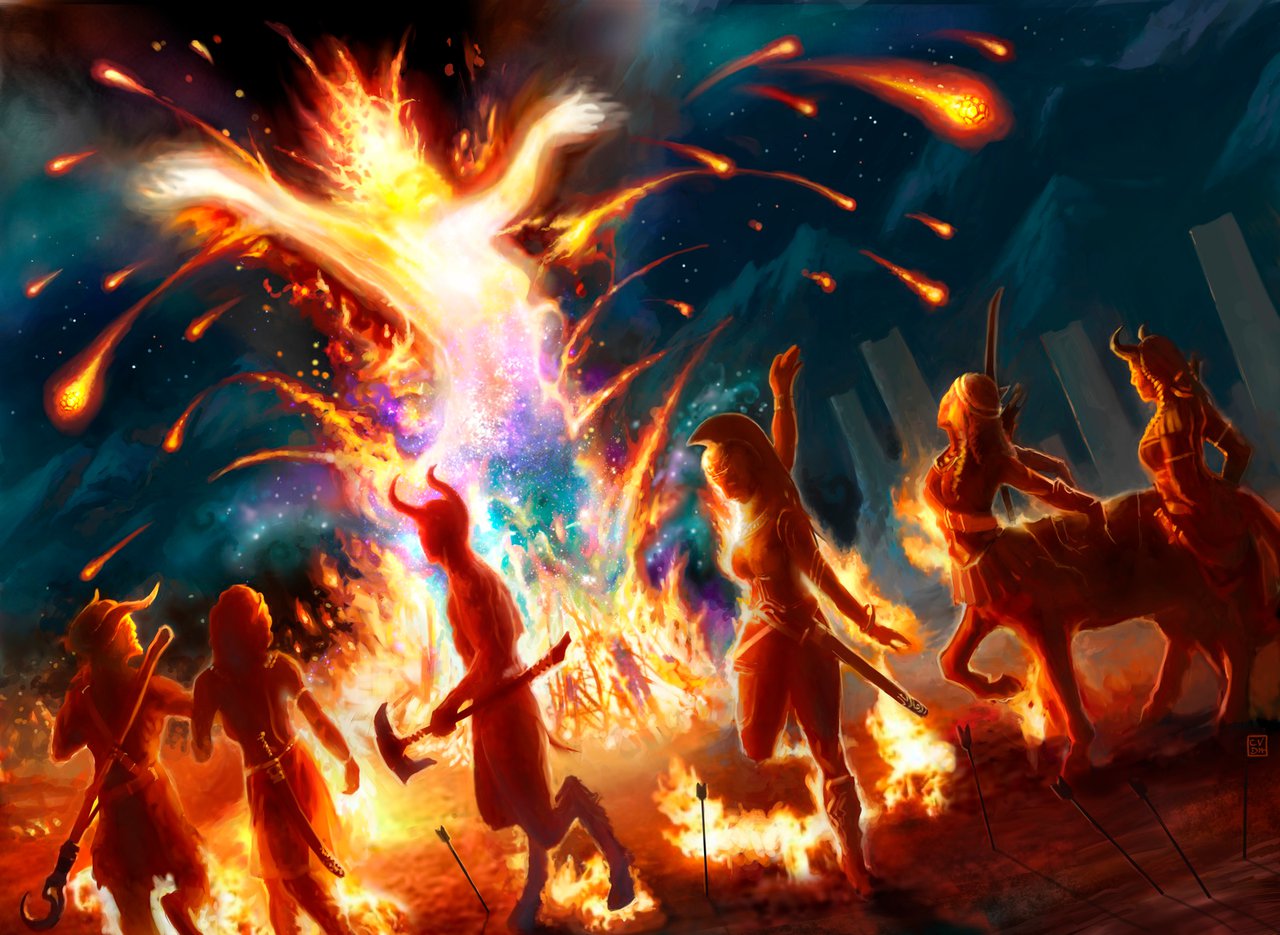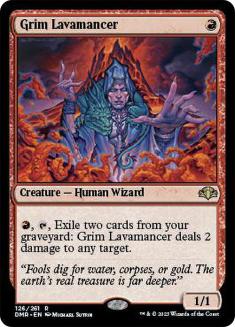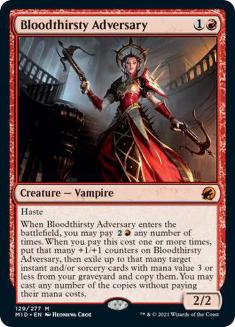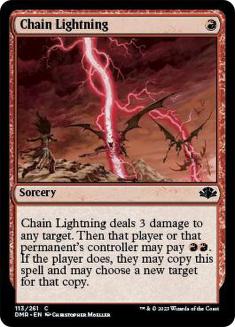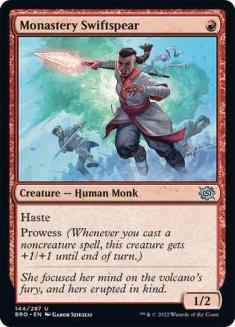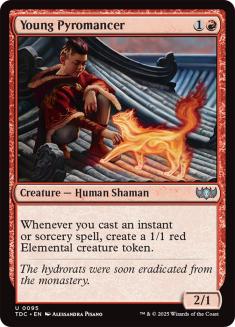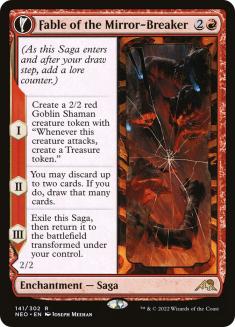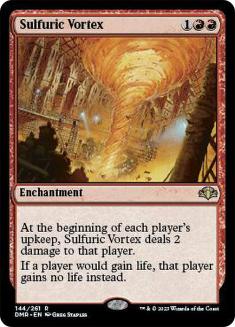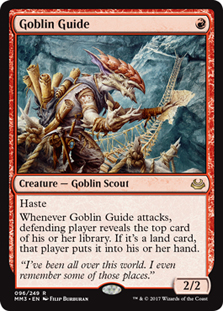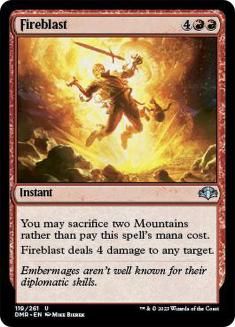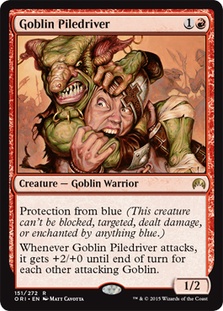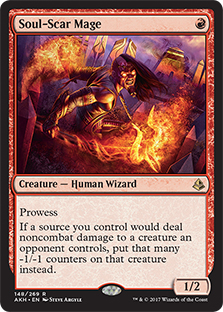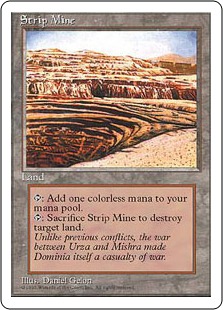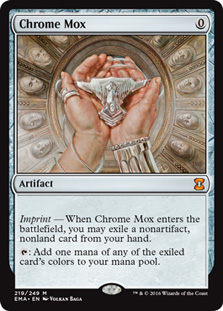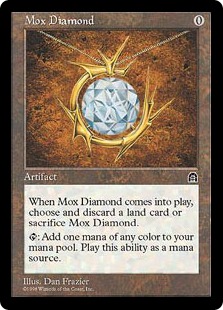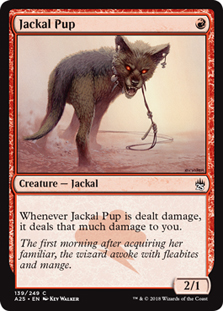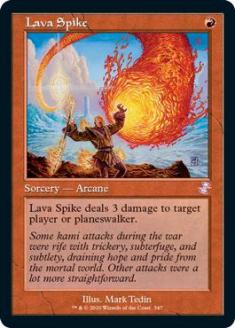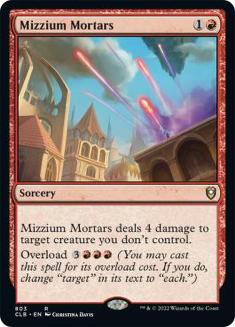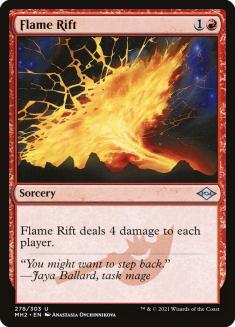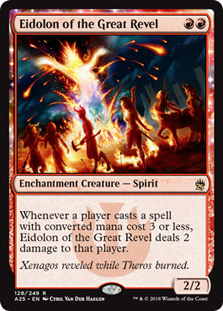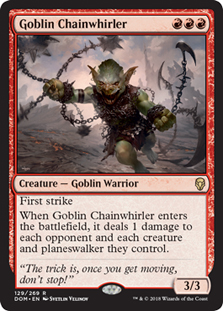Hello again, gamers. I hope that everybody is having a good Cubemas! I’ve had some awesome Broken Blue decks and even had a pleasantly surprising trophy with a Naya pile. The highlight of the season for me so far has been a good old-fashioned unbeatable Fact or Fiction.
Today, I’d like to talk about something a little more old-fashioned. Sophisticated in its elegance. Something that really speaks to the fundamentals of Magic: The Gathering. Today, I’d like to offer a Deep Dive on Mono-Red Aggro as a Cube Archetype.
What Is Mono-Red Aggro?
There’s not a lot to dissect in the name here. Mono-Red Aggro is an aggressive deck that preferably sticks to only red and colorless cards. That distinction is worth noting, though, as nearly every digital Cube that we’ve seen has generated mono-red decks that perform on average better than aggressive red decks splashing any additional color, and I only say “nearly” every Cube to allow for some exception that I don’t remember off-hand. I do remember that MenguCube had more of an emphasis on supporting Boros than mono-red or mono-white, but I also remember the Boros decks in that Cube fighting with their manabases more than aggressive decks realistically can afford to in high-powered environments.
How Does Mono-Red Aggro Work?
Mono-Red Aggro has a near-singular focus on dealing damage. Most often in Cube, this means casting cheap creatures and using burn spells to clear the way or finish off the opponent. In lower-powered Cubes, you’ll see some emphasis on removal that can only target creatures, like Flame Slash or Fire Prophecy, that can’t end the game out of nowhere by targeting the opponent, and in high-powered Cubes, you’ll see an emphasis on land and/or artifact destruction to keep pace with the broken fast mana that opponents can use to cast spells that far outclass little red creatures.
Among the most important elements of successful Mono-Red Aggro decks is a relatively low mana curve. It’s good to have mana sinks and things to do with your mana as the game progresses, but the ideal case for the red player is that the game doesn’t last all that long. The best-in-class Magic cards for just dealing damage in non-multiplayer environments tend to be low-mana-value cards like Lightning Bolt, and as you move up the mana curve, you run into best-in-class cards that serve as powerful opposition to aggressive decks: sweepers, giant blockers, lifegain. Monastery Swiftspear is here for a good time, not a long time.
This is part of why red aggressive decks prefer to be mono-red. Stumbling on mana can put you a turn behind your plan, and closing in combat or with burn spells becomes more difficult with each turn that passes. You want a well-oiled machine with a lean curve and a stack of basic Mountains that cast all of your spells. If you can get your opponent to a small single-digit life total early, then you can win a long game with some burn, but if you fail in this goal, things only get harder for you as the game progresses.
How Should I Approach Drafting Mono-Red Aggro?
There’s some unfortunate math when it comes to drafting mono-color decks in eight-player drafts. There are only five colors of Magic, so you can’t fight too many other players while successfully keeping your deck to one color. You can usually tell pretty early in Pack 1 if the lane might be open by what sorts of red cards are still in the pack around Picks 4-5, and if you find yourself not wheeling cheap red creatures, then you know you probably won’t be able to get enough playables for a mono-color aggro deck.
This notion informs what sorts of cards you should first-pick when it comes to drafting Mono-Red Aggro. If we’re looking to wheel the cheap creatures that nobody else wants, that means we should prioritize the cards that drafters in other archetypes do want. Efficient removal spells like Chain Lightning and creatures that generate value like Young Pyromancer usually don’t make it all the way around the table, so they’re good ones to look out for early. Part of the idea here is that you want to keep the option open to play one of those non-mono-red archetypes yourself. First-picking a card like Fable of the Mirror-Breaker isn’t necessarily going to put you into mono-red, but you’ll absolutely play it in your mono-red deck, and it’s a better card on average than something fragile like Magda, Brazen Outlaw.
Some of the discussion about drafting Mono-Red Aggro centers around identifying the most powerful individual cards for the archetype and honing in on those. I’ve been known to first-pick a Sulfuric Vortex, though as a rule I’d caution against moving in on red because of any individual card. It’s paramount to these decks that you end up with a high volume of cheap threats and a good clip of burn, and one or two best-in-class cards simply won’t salvage a Mono-Red Aggro deck with a rough mana curve or that is otherwise shy on playables. Casting Goblin Guide on one and closing with Fireblast are both powerful plays, but when it comes to drafting, they really only shine when the rest of the deck also comes together.
As such, you want to look and see if there’s at least one additional red aggressive card that you can expect to wheel when you draft aggressive red cards early. Otherwise, that Sulfuric Vortex is going to look really awkward next to your Sylvan Library. It’s not just that aggressive red decks require a high volume of the right stuff; it’s that many of them really don’t play well anywhere else.
Another thing to look out for as a drafter is that it’s fairly common to see some kind of sideways archetype that lines up with Mono-Red Aggro. A fairly common example is Goblins as a creature type that matters. When you see something like Goblins that is super-narrow and basically only for aggressive red drafters, that’s the sort of stuff you should absolutely plan to wheel. You could get away with picking something like a Krenko, Mob Boss early because it generates value, but a Goblin Piledriver is going to be awful in anything but the most open draft for a red player. Most individual Goblins are too weak to really move in on something like that aggressive.
Soul-Scar Mage is a less obvious example of the same thing. Soul-Scar Mage might not represent an entire prowess archetype, but it does suggest that if you want to attack for two, you’ll need to be casting some noncreature spells. There’s already enough pressure on red decks to find the removal spells they need when you factor in that one of the cards that other players are most interested in is Lightning Bolt, which brings us to the natural conclusion that Falkenrath Gorger is good for more damage on average than Soul-Scar Mage for a Mono-Red Aggro deck. Monastery Swiftspear’s haste makes it a much more desirable card, but non-hasted prowess threats should get some scrutiny.
Alternatively, a powerful and well-supported archetype like Sacrifice can be a great line for a red drafter to take as you figure out if your lane is more open to Mono-Red Aggro or Rakdos Sacrifice. This sort of approach works because cards like Goblin Bombardment will actually reliably be among the most powerful cards in a Cube, which makes it a smart hedge, as opposed to digging yourself into a hole and trying to fill it with as many Goblins as you can find.
To take this a step further, and in a way that’s relevant to Vintage Cube currently live on Magic Online (MTGO), the most powerful cards to open on for Mono-Red Aggro in Vintage Cube aren’t even red. There are the obvious artifacts Mox Ruby, Mana Crypt, and Black Lotus, but I would be willing to bet that the most frequent first pick that I make when I draft red in Vintage Cube is Strip Mine. You just need something that can try to press an advantage that Hellrider simply can’t on its own against the most powerful Magic cards of all time. To that end, the “weaker” fast mana cards, like Chrome Mox and Mox Diamond, become important pickups for Mono-Red Aggro to keep pace with the truly powerful archetypes.
To extend that to other environments, beyond just volume of red cards, you really need to pay a lot of attention to your mana curve when drafting Mono-Red Aggro in any Cube. When the Cube is at an incredibly high power level, that means drafting fast mana, and as that power scales down, it just means to make sure you’re doing something with your mana every turn of the game, starting on Turn 1. It can be tempting to pick up four- and five-mana spells early to make sure you have some top-end, but you’ll lose games before you’re able to cast Thundermaw Hellkite if you’re not able to curve out on the early turns. Fours and fives have a way of being broadly interchangeable, and you just need a lot of ones and twos.
As a rule, I like to keep my aggressive red decks mono-color, but sometimes you can notice the wheels falling off despite some early signs that the lane is open. I would never take a mana-fixing land over a cheap red aggressive creature if it looked like I had a chance to stay mono-red, but I always keep my eyes open in case I need to move in on a second color. Seeing as stumbling on mana is a great way for an aggro deck to fall behind and stay behind, I usually keep my eyes out for the mana-fixing lands first and spells in a second color second. If I’m looking at spells before lands, that typically means I’m trying to abandon red entirely, rather than hoping that I can hit the right lands.
How Fun Is Mono-Red Aggro?
Mono-Red Aggro is often referred to as “the fun police,” so by some estimates it’s not a very fun deck at all! A good Mono-Red Aggro deck will punish any deck that stumbles and most decks that are more interested in doing something cool over doing something powerful, but it can be an important part of an ecosystem to make sure a Cube isn’t just about who casts the most expensive and powerful spells by forcing players to worry about somebody going under them.
When you love playing too many five-mana spells and not worrying too much about what your opponent is doing, you hate playing against mono-red. Personally, it always seems super reasonable to me when I lose to a Mono-Red Aggro deck, especially in high-powered Cubes. If anything, I’m jealous that my opponent got a great red deck, knowing how often my attempts at drafting the archetype have come up short.
I will say that a lot of players have a strong aversion to drafting Mono-Red Aggro, which leads to a lot of last-pick Jackal Pups and the like and can be very detrimental to a Cube group if nobody wants to draft the archetype. This sort of trend, to me, is worth paying a lot more mind to than how the red deck itself plays when it shows up. I value a balanced environment pretty highly, but it’s of fundamental importance to present the players drafting your Cube with decks that they actually want to draft and play.
Maybe you’re like me, and you once enjoyed forcing Mono-Red Aggro and speed-running drafts of the Arena Cube. Maybe you’re like David McDarby, and you want players to win in spectacular fashion with minimal access to cheap creatures. I do find Mono-Red Aggro to be a reliable archetype for players to explore when drafting a new Cube, which is a useful element of familiarity, but it’s by no means a necessity, and the customer is always right in matters of taste.
How Do I Support Mono-Red Aggro as a Cube Designer?
Just like when it comes to drafting Mono-Red Aggro, the Cube designer is successful at seeding the archetype by featuring a high volume of cheap aggressive cards in the Cube, and being mindful of the sorts of large blockers and lifegain effects the red deck will have to combat. There’s a significant delta with regard to how impactful Goblin Guide or even Ragavan, Nimble Pilferer can be as it pertains to opposing access to blockers and removal spells. The most important note that I have, and one that I keep repeating, is that the volume of good aggressive red cards and nature of opposing decks matter than what the most powerful aggressive red cards are.
I will say that there is a line where the cards you can feature to support Mono-Red Aggro can be too weak, and/or too narrow. I already discussed how Goblins is a generally narrow lane, but now I want to call attention to Lava Spike as a fundamentally flawed Cube card. Unless your Cube has some kind of color restriction, you’ll rarely see so much as two great red aggressive decks at one table. Lava Spike has essentially zero play to it in Cube, and it goes in exactly one deck — a deck that is generally more interested in Mizzium Mortars than Flame Rift. While it is true that Jackal Pup is a weaker card in many ways than Lava Spike, it is a much better ingredient in Cube than one-shot burn effects that can’t remove blockers.
Eidolon of the Great Revel and Goblin Chainwhirler are two examples of commonly Cubed cards that basically only play in Mono-Red Aggro that work much better to draw players to the archetype than Lava Spike and company. They’re difficult to cast, but there are games where they’re the best card in your deck, which is what you want out of a narrow card to the extent that you want any narrow cards in your Cube at all. The restrictive casting costs make them great candidates for cards to wheel in Packs 2 and 3, and it’s nice to have a handful of cards that players can plan on wheeling in a particular archetype.
Rather than pushing Mono-Red Aggro with a ton of very specific cards, I find that a lot more fun can be had in facilitating the sideways archetypes. Young Pyromancer is a beloved Cube staple that bridges aggressive red decks to spells-matters strategies, and Sacrifice is another common example that I believe works very well. My favorite less commonly featured example is Madness, which is my most-drafted archetype in my Spooky Cube. Stuff like Goblins that mostly just makes your red decks even more specific or Lava Spike that makes it difficult for them to take a controlling role in any games just won’t work nearly as well in my experience as offering some flexibility in draft lanes.
Whether you’re a love or a hater of Mono-Red Aggro in Cube, it’s one of the most commonly supported Cube archetypes of all time, and is necessarily so simply with regard to the way that red cards are designed. It’s not an archetype that is essential to every Cube, but it’s one that is important to know your way around as both a player and a designer.

